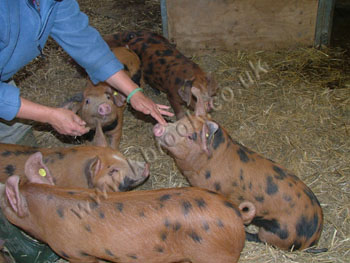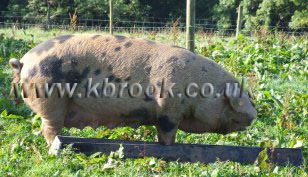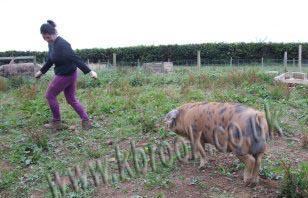PIGS IN GENERAL
Pig, Hog, Peccaries, Swine…
On this page I want to cover, although briefly, the pig in general.
Pigs may be Artiodactyls – even-toed, hoofed animals closely related to sheep, goats, deer and cattle – but they have no equals in the order.
Pigs are different. They think, work and play outside the pen. Their structure and basic design have changed very little during the last 40 million years, but something interesting has happened inside their heads, something that makes them the most engagingly idiosyncratic of all ungulates.
Biologists recognise that there are many things about pigs we just have to guess at, as our experience of them in the wild is so limited, witnessing no more than a tiny fraction of their lives. Even in captivity, pigs are seldom given the chance to show us what they can truly do. Most of the research on domestic pigs is market-driven, governed largely by concerns about productivity. And the analysis of what pigs are is often untidy, uninspired and inclined more to what we want, or imagine, pigs to be.
So pigs remain mysterious. No other group of living things has been so often discussed and so little understood. Few animals are the object of more deeply rooted misapprehensions, or more passionate justifications. And none carry a greater burden of confusion, being simultaneously described as ‘beautiful’ and ‘hideous’, ‘greedy’ and ‘restrained’, ‘clever’ and ‘ignorant’, ‘pure of heart’ and ‘instruments of the devil’.
Pigs in general can make us uneasy. They return our scrutiny and never give an inch. They know what’s happening, and let us know what’s happening. They are out of our control and that leaves us with uncomfortable feelings that find expression in more superstitions ceremonies, folk-tales and taboos than we attach to any other creature.
The way in which pigs have become scapegoats for all our own most foul and bestial attributes is, however, a dead giveaway. Pigs, more than anything else, remind us of ourselves – and that is why I find them so fascinating.

Winston Churchill once said: ‘Cats look down on you; dogs look up to you; but pigs look you in the eye as equals.’ Pigs on the whole, are poker-faced, giving little away, but they can be surprisingly eloquent.
The Oxford English Dictionary decides that ‘pig’ itself is etymologically obscure but probably derives from Old English pigg, pige or pygge, and was originally applied to the ‘young of a swine’. ‘Swine’, in its turn, is more Teutonic, from suine, swiyne or swynne, and was properly used for domestic animals.
German and Early Modern Dutch derivatives such as pigga and vigghe merely add to the confusion. As do claims that ‘pig’ today can be applied as easily to: a block of salt, a parcel of hemp, a printer, an iron ingot or a piece of lead for ballast, an item sent through a pipeline, a small cushion, a male chauvinist and a large policeman.
But a pig is a pig to mean any member of any age, in any country or condition of the lineage of Suiformes – as long as it is not a hippopotamus. That means any even-toed ungulate that isn’t aquatic, doesn’t ruminate and does have old fashioned, low crowned teeth. That’s about as simple as it can be but pigs always start out looking simple and tend to get complex rather quickly.
In Latin, things are easier. A pig is porcus, which not only defines the animal but also describes its meat and at least one of it species. And the stem genus in the whole group is Sus, from the Latin for a sow. Therefore, leading to the usage, by the Anglo-Saxon sugu for sow, Cornish hoch for a boar, and Irish suig for both sexes – a form that was carried across the Atlantic in the sixteenth century as ‘hog’, which is how most Americans describe any animal that resembles the lean, long-snouted, razor-backed descendants of the Eurasian wild boar that were introduced to the Americas and possibly Australasia by the first Spanish colonists.

Putting aside the fact that ‘hogs’ now also apply to ten-cent coins in the United States, motorcycles and anyone who behaves in a greedy fashion, the confusion between the ‘pig’ and the ‘hog’ remains, and is enshrined in the common names for wild suids. The largest and the smallest ones are hogs – Forest Hogs and Pigmy Hogs –while the rest are pigs. And the two very closely related species in the genus Potamochoerus are described as Bush Pigs and Red River Hogs.
There is no logic in it at all, and the best way to point this out is that all suids are Pigs unless they are Forest, Pigmy or Red River Hogs; or belong to any one of three species confined to the Americas and Australasia, where they have always been known as pecari or peccaries, meaning ‘animals which make many paths through the forest’.
And while we are on the subject, it may help to know that within any wild species or domestic breed, boars are adult males; sows are breeding females; barrows are male pigs that have been castrated before reaching sexual maturity; gilts are females who have not had a litter; shoats are adolescent, newly weaned males; and the rest, infants of both sexes up to the age of weaning, are suckling pigs or piglets.
So an air of mystery surrounds pigs. They are slippery creatures, literally and metaphorically hard to pin down. With the exception of their splendid snouts, they are structurally primitive, unspecialised and unrepentantly primal. And yet by general agreement, they are regarded as highly intelligent, up there with apes and dolphins. Few other animals can match them for their combination of simplicity and complexity.
